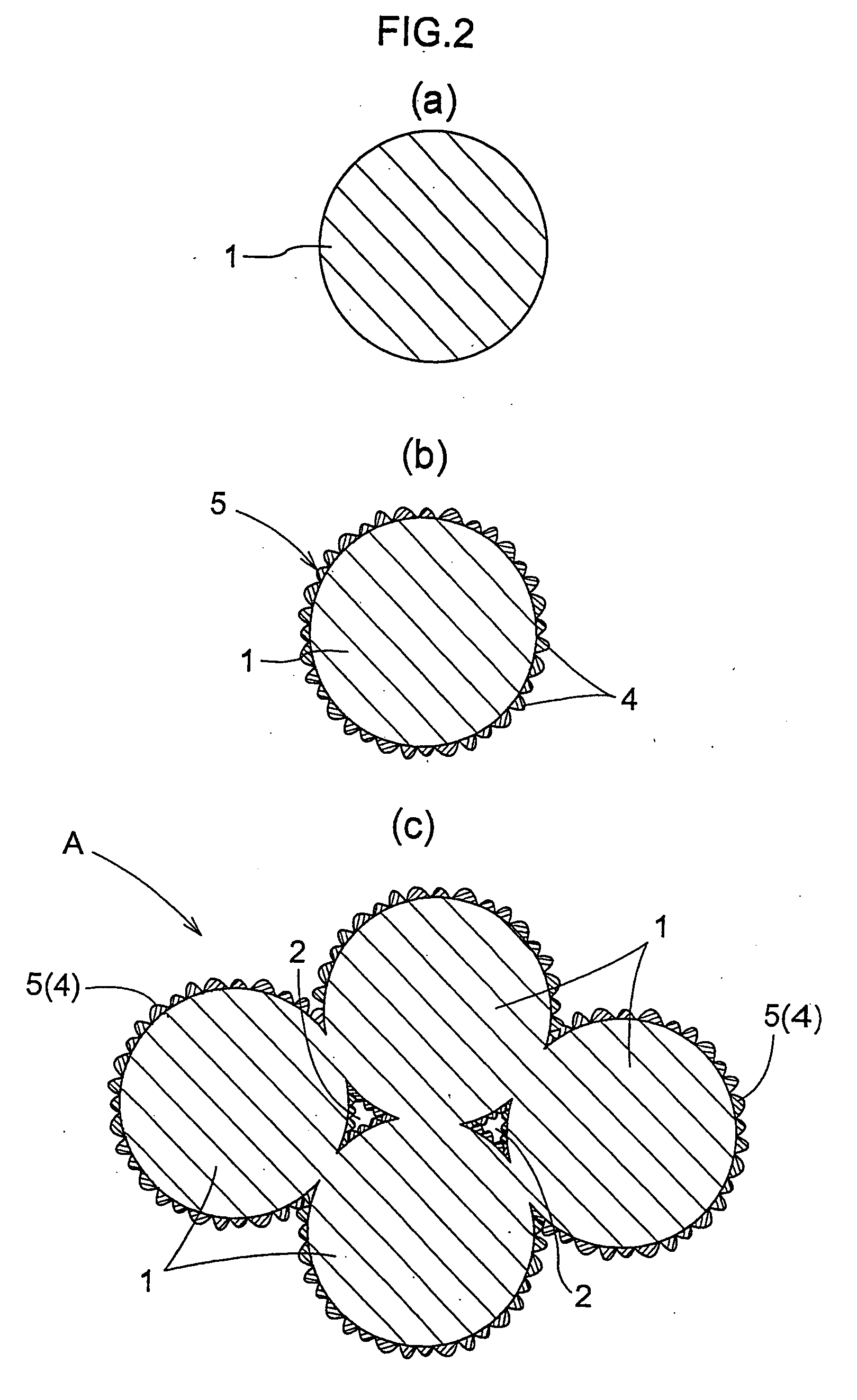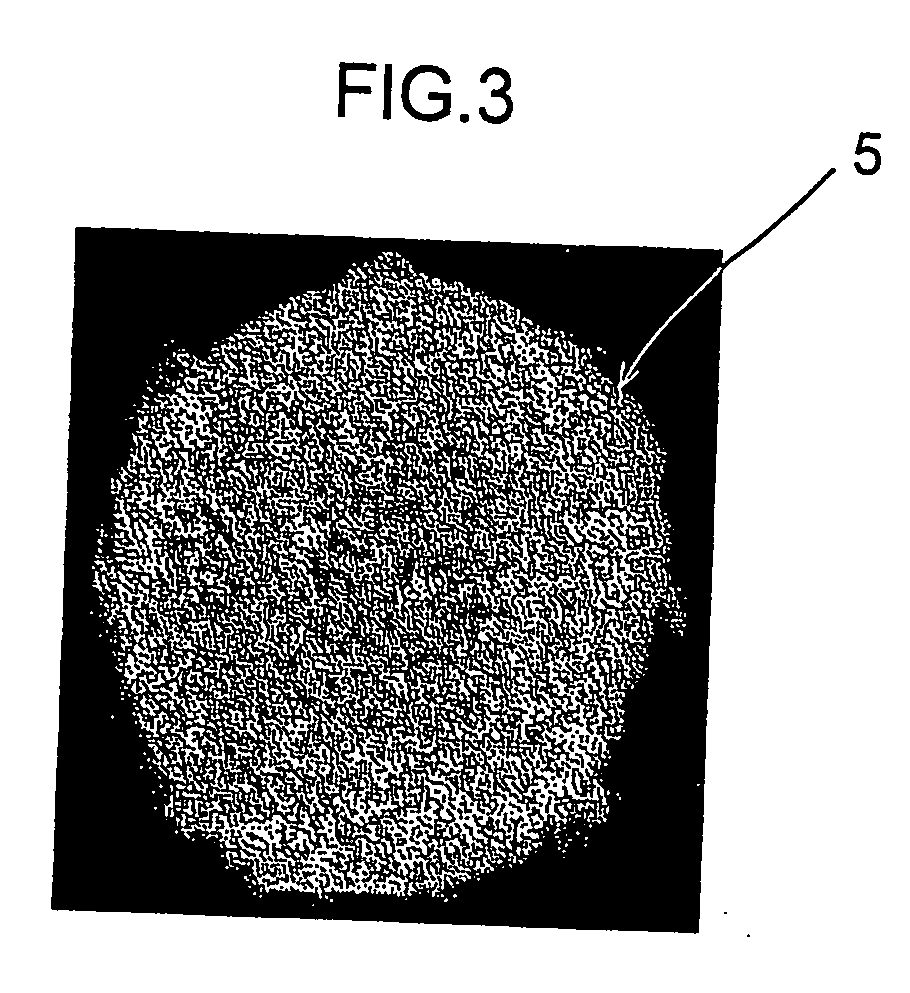Metal resin composite and process for producing the same
a technology of metal resin and composites, applied in the field of metal resin composites, can solve the problem of inability to secure uniform physical properties easily, and achieve the effect of low cos
- Summary
- Abstract
- Description
- Claims
- Application Information
AI Technical Summary
Benefits of technology
Problems solved by technology
Method used
Image
Examples
example 1
[0053] Polytetrafluoroethylene (PTFE) was selected as thermoplastic resin, and a surface adjusting treatment was performed on PTFE particles 1 whose mean particle diameter was 20 μm, by using a fluoric cation surface active agent as surface-treating agent. Specifically, the PTFE particles 1 were agitated in an aqueous solution of 0.75 g / L[C8F17SO2NH(CH2)3(CH3)2N+]I− at 70° C. for 10 minutes, and were then thoroughly rinsed. As the surface-treating agent, also usable besides fluoric cation surface active agent are a cation surface active agent other than fluoric, an anion surface active agent and a nonion surface active agent.
[0054] After the surface treatment, the surfaces of PTFE particles 1 were catalytically activated by repeating twice a sensitivity applying treatment with a sensitizer, thorough rinsing, a catalyst applying treatment with an activator, and thorough rinsing. The catalytic activation of the surfaces may be carried out also by repeating a catalyst applying step an...
example 2
[0059] Polymethyl methacrylate (PMMA) which is an example of methaciylic resin was selected as thermoplastic resin, and a surface adjusting treatment as in the first example and electroless Ni-PTFE plating were performed on PMMA particles 1 whose mean particle diameter was 10 μm, to form metal coating 5 on the surfaces of PMMA particles 1. The bath composition and conditions of the Ni-PTFE plating solution are shown in Table 3 below.
TABLE 3nickel sulfate 15 g / Lsodium hypophosphite 14 g / Lsodium hydroxide 8 g / Lglycine 20 g / LPTFE (particle diameter: 0.3 μm) 15 g / Lsurface active agent0.5 g / LpH9.5bath temperature90° C.agitating time40 min.
[0060] After the electroless Ni-PTFE plating treatment, the particles were thoroughly rinsed and put to vacuum reduced pressure drying for five hours. The amount of plating was 59.1% by weight, and an average plating film thickness was 0.32 μm.
[0061] The conductive particles obtained in this way were spread thin over a stainless plate, and roll-pres...
example 3
[0062] Polytetrafluoroethylene (PTFE) was selected as thermoplastic resin, and a surface adjusting treatment as in the first example and electroless Cu-PTFE plating were performed on PTFE particles 1 whose mean particle diameter was 20 μm, to form metal coating 5 on the surfaces of PTFE particles 1. The bath composition and conditions of the Cu-PTFE plating solution are shown in Table 4 below.
TABLE 4copper sulfate 7 g / LPotassium sodium tartrate20 g / Lsodium hydroxide10 g / Lformalin 4 ml / LpH12bath temperature30° C.agitating time10 min.per 1 mL of formalin
[0063] The plating solution is first treated with chemicals except formalin in Table 1. After placing the PTFE particles 1 in the plating solution, formalin was added 1 mL at a time while agitating the solution. The formalin injection was carried out at intervals of 10 minutes. After the plating, the particles were thoroughly rinsed and put to vacuum reduced pressure drying for one hour. The amount of plating was 58.7% by weight, an...
PUM
| Property | Measurement | Unit |
|---|---|---|
| Diameter | aaaaa | aaaaa |
| Diameter | aaaaa | aaaaa |
| Temperature | aaaaa | aaaaa |
Abstract
Description
Claims
Application Information
 Login to View More
Login to View More - R&D
- Intellectual Property
- Life Sciences
- Materials
- Tech Scout
- Unparalleled Data Quality
- Higher Quality Content
- 60% Fewer Hallucinations
Browse by: Latest US Patents, China's latest patents, Technical Efficacy Thesaurus, Application Domain, Technology Topic, Popular Technical Reports.
© 2025 PatSnap. All rights reserved.Legal|Privacy policy|Modern Slavery Act Transparency Statement|Sitemap|About US| Contact US: help@patsnap.com



